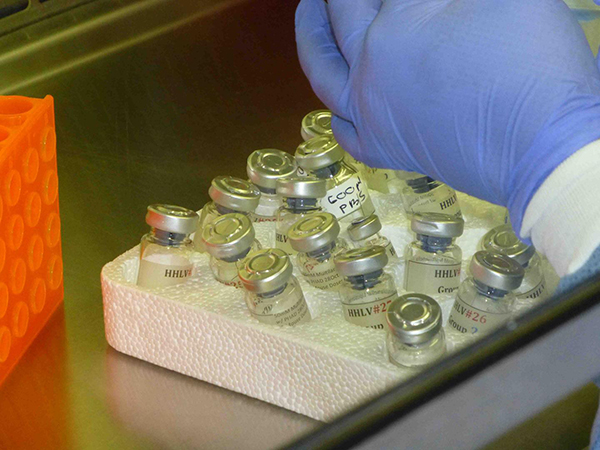A new vaccine technology takes a slightly roundabout path to blocking the psychoactive effects of opioids, but it could have straightforward benefits, helping prevent opioid overdoses, which kill 91 Americans every day. The technology induces antibodies to bind to opioids such as heroin to prevent them from crossing the blood–brain barrier.
This technology, which was developed by researchers with the U.S. Military HIV Research Program at the Walter Reed Army Institute of Research (WRAIR), can overcome a significant challenge to the design of a heroin vaccine. The difficulty is that heroin and its metabolites are haptens that are unable to induce antibodies by themselves.
The WRAIR researchers decided that if they were going to assemble an opioid vaccine, they would begin with a haptenic opiate surrogate and conjugate it to an acceptable protein carrier. The researchers also focused on finding an adjuvant that would be safe and effective for humans, so that the vaccine would be able to achieve a broad profile of high titer antihapten antibodies.
By taking this approach, the researchers devised an improved synthesis of a haptenic heroin surrogate 1 (6-AmHap). This experimental vaccine, the researchers determined, bound to heroin and other abused opioids, including hydrocodone, oxycodone, hydromorphone, oxymorphone, and codeine. By inducing antidrug antibodies, the vaccine prevented the drugs from crossing the blood–brain barrier in mice and rats.
Detailed findings appeared December 13 in the Journal of Medicinal Chemistry, in an article entitled “A Stable Heroin Analog That Can Serve as a Vaccine Hapten to Induce Antibodies That Block the Effects of Heroin and Its Metabolites in Rodents and That Cross-React Immunologically with Related Drugs of Abuse.” The article describes a vaccine that appears to dampen the impact of heroin at a high dose, an effect that might indicate a way to prevent overdose.
“The 1 vaccine induced high anti-1 IgG [immunoglobulin G] levels that reduced heroin-induced antinociception and locomotive behavioral changes following repeated subcutaneous and intravenous heroin challenges in mice and rats,” wrote the article’s authors. “Vaccinated mice had reduced heroin-induced hyperlocomotion following a 50 mg/kg heroin challenge.”
In clinical settings, it is essential that the antibodies induced by a heroin or opioid vaccine do not cross-react with the therapies for opioid misuse, such as methadone, buprenorphine, and naltrexone. Researchers found that the antibodies did not react with these compounds and, more importantly, the antibodies induced by the vaccine did not cross-react with naloxone, which is used as the overdose rescue treatment to reverse respiratory depression due to heroin overdose or overdose with other opioids.
Although the use of opioids for pain management in people suffering from addiction is of concern, researchers found that methadone, tramadol, fentanyl, sufentanil, nalbuphine, and buprenorphine did not bind to the antibodies, indicating that they could be used if acute pain treatment is required for emergency use in vaccinated patients. Researchers also found that there was no binding to the nonnarcotic pain relievers like aspirin, ibuprofen, and acetaminophen, so these would likely remain effective.
“By eliciting antibodies that bind with heroin in the blood, the vaccine aims to block the euphoria and addictive effects,” said Gary Matyas, Ph.D., chief of adjuvants and formulations for the U.S. Military Research Program (MHRP), WRAIR. “We hope to give people a window so they can overcome their addiction.”
WRAIR researchers leveraged their expertise in vaccine development and novel adjuvants research to develop this experimental heroin vaccine with their partners at the National Insitute on Drug Abuse (NIDA). The vaccine includes a potent adjuvant to stimulate the immune system called the Army Liposome Formulation (ALF), which was also developed by researchers at WRAIR.
“A scalable procedure was developed to install the C-3 amido group,” the article in the Journal of Medicinal Chemistry detailed. “Using the Boc protect[i]ng group in 18 allowed preparation of 1 in an overall yield of 53% from 4 and eliminated the necessity of preparing the diamide 13. Hapten 1 was conjugated to tetanus toxoid and mixed with liposomes containing monophosphoryl lipid A as an adjuvant.”
Most pharmacological treatments for opioid misuse involve opioid management therapy (OMT), but treatment access is an issue. In addition, adherence varies greatly and relapse rates can be high. To end the opioid overdose crisis, many different types of treatments and medications will be needed to meet the needs of individuals addicted to these drugs.
“Although we are still in the early phase,” noted Dr. Matyas, “this study suggests that vaccination can be used together with standard therapies to prevent the withdrawal and craving symptoms associated with opioid withdrawal.”


